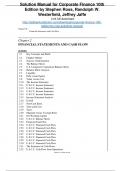Exam (elaborations)
Solution Manual for Corporate Finance 10th Edition by Stephen Ross, Randolph W. Westerfield, Jeffrey Jaffe
- Course
- Institution
CHAPTER ORGANIZATION 2.1 The Balance Sheet Liquidity Debt versus Equity Value versus Cost 2.2 The Income Statement Generally Accepted Accounting Principles Noncash Items Time and Costs 2.3 Taxes Corporate Tax Rates Average versus Marginal Tax Rates 2.4 Net Working Capital ...
[Show more]



